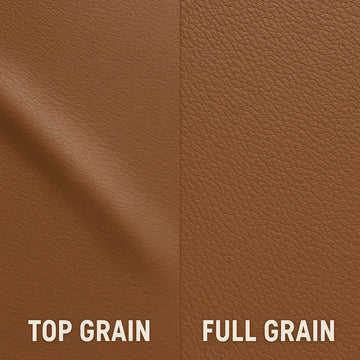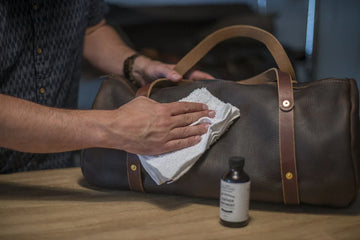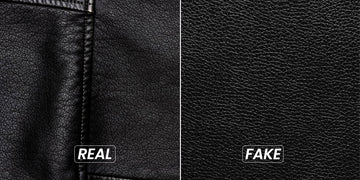If you’re entering the world of leather goods—whether as a shopper, maker, or enthusiast—understanding the difference between full-grain leather and top-grain leather is essential. These two types are among the most popular in high-quality leather products, yet many people confuse them due to the similarity in names.
This guide offers a detailed breakdown to help you make informed decisions when choosing leather for furniture, bags, shoes, or custom goods.

What is Full-Grain Leather?
Full-grain leather is the highest quality leather available. It is made from the top layer of the hide, just beneath the hair, and retains its original grain. No sanding or buffing is applied, meaning the surface stays natural and unaltered.
Characteristics:
-
Natural texture: Includes visible pores, scars, and grain patterns.
-
Maximum strength: Because the grain remains intact, the fibers are densely packed, offering exceptional durability.
Breathability: Unfinished or semi-finished full-grain leather allows air to pass through, making it comfortable over time. -
Aging process: Develops a natural patina with use, enhancing its character.
Common Tanning:
Full-grain leather is usually vegetable-tanned or dyed with aniline or semi-aniline methods. These processes maintain the organic structure and allow the leather to age gracefully.

What is Top-Grain Leather?
Top-grain leather is also sourced from the upper layer of the hide, but it is sanded and treated to remove imperfections such as blemishes, scars, and inconsistencies.
Characteristics:
-
Smooth finish: The sanding process evens out the surface for a more consistent appearance.
-
Protective coating: A thin surface coating or pigmentation layer is often applied to enhance stain resistance and uniformity.
-
Softer feel: More pliable and easier to work with than full-grain leather.
-
Less visible aging: It does not develop a patina over time in the same way full-grain leather does.
Common Tanning:
Top-grain leather is typically chrome-tanned, which is faster and results in a softer, more flexible product.

Full-Grain vs Top-Grain: Side-by-Side Comparison
|
Feature |
Full-Grain Leather |
Top-Grain Leather |
|
Surface |
Unaltered, natural grain |
Sanded to remove imperfections |
|
Appearance |
Organic, may include natural markings |
Uniform, smooth surface |
|
Durability |
Extremely high |
High, but slightly reduced due to sanding |
|
Breathability |
Excellent |
Moderate |
|
Patina development |
Rich patina over time |
Minimal patina |
|
Maintenance |
Requires conditioning |
Easier to clean |
|
Price |
Premium |
Mid-range |
|
Typical use cases |
Luxury bags, shoes, heritage items |
Upholstery, fashion goods, car interiors |
Pros and Cons of Each Type
Full-Grain Leather
Advantages:
-
Superior strength and longevity
-
Natural look and feel
-
Patina develops over time for added character
Disadvantages:
-
More expensive
-
Can be harder to work with
-
Visible imperfections may not appeal to everyone
Top-Grain Leather
Advantages:
-
More affordable than full-grain
-
Easier to maintain and clean
-
Smooth, consistent appearance
Disadvantages:
-
Slightly less durable
-
No patina development
-
Less natural in feel and look
Applications and Use Cases
Full-Grain Leather:
-
Premium wallets, belts, and footwear
-
High-end briefcases and leather bags
-
Bespoke furniture and heirloom goods
-
Handmade leather goods with focus on longevity
Top-Grain Leather:
-
Sofas and chairs
-
Fashion accessories
-
Leather jackets and outerwear
-
Vehicle interiors
How to Tell the Difference
When inspecting a leather product, consider the following:
-
Texture: Full-grain leather will show irregularities, natural grain, and variation. Top-grain will be smoother and more uniform.
-
Labels: Reputable manufacturers will specify the type. Be wary of vague terms like “genuine leather,” which often refers to lower-quality materials.
-
Touch and flexibility: Full-grain is typically firmer, while top-grain is softer and more pliable.

Which Leather Type is Right for You?
Choosing between full-grain and top-grain leather depends on your priorities:
-
Choose full-grain leather if you value long-term durability, authenticity, and don’t mind natural markings or a higher price tag.
-
Choose top-grain leather if you want a cleaner, more uniform appearance, easier maintenance, and a slightly lower price point.
Understanding the distinction between full-grain and top-grain leather can significantly impact your purchase decisions, especially if you're investing in long-lasting or high-end leather goods. Both are excellent materials—far superior to bonded or “genuine” leather—but they serve different purposes and aesthetics.
If you appreciate authenticity, aging beauty, and ultimate durability, full-grain leather is your best choice. If you prefer something sleek, soft, and easy to manage, top-grain leather delivers excellent value without compromising too much on quality.


















